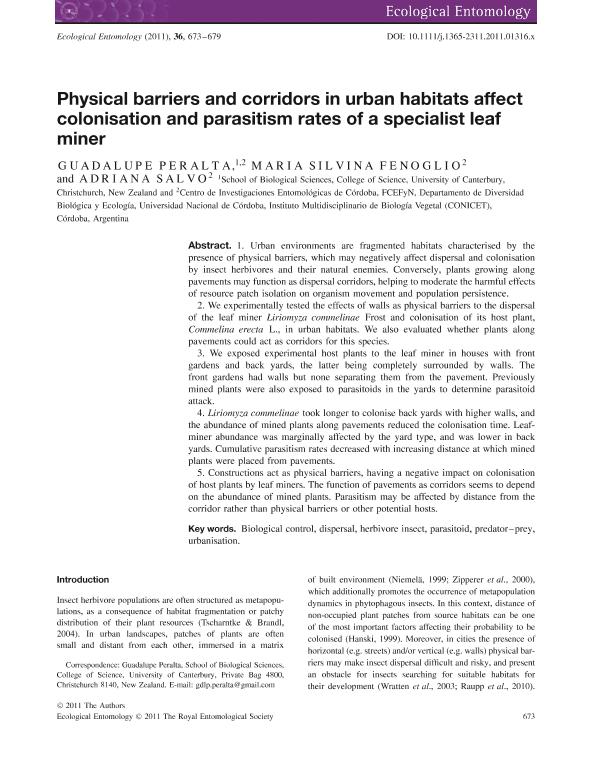Mostrar el registro sencillo del ítem
dc.contributor.author
Peralta, Guadalupe
dc.contributor.author
Fenoglio, Maria Silvina

dc.contributor.author
Salvo, Silvia Adriana

dc.date.available
2017-03-30T18:02:16Z
dc.date.issued
2011-10
dc.identifier.citation
Peralta, Guadalupe; Fenoglio, Maria Silvina; Salvo, Silvia Adriana; Physical barriers and corridors in urban habitats affect colonisation and parasitism rates of a specialist leaf miner; Wiley; Ecological Entomology; 36; 6; 10-2011; 673-679
dc.identifier.issn
0307-6946
dc.identifier.issn
1365-2311
dc.identifier.uri
http://hdl.handle.net/11336/14520
dc.description.abstract
1. Urban environments are fragmented habitats characterised by the presence of physical barriers, which may negatively affect dispersal and colonisation by insect herbivores and their natural enemies. Conversely, plants growing along pavements may function as dispersal corridors, helping to moderate the harmful effects of resource patch isolation on organism movement and population persistence. 2. We experimentally tested the effects of walls as physical barriers to the dispersal of the leaf miner Liriomyza commelinae Frost and colonisation of its host plant, Commelina erecta L., in urban habitats. We also evaluated whether plants along pavements could act as corridors for this species. 3. We exposed experimental host plants to the leaf miner in houses with front gardens and back yards, the latter being completely surrounded by walls. The front gardens had walls but none separating them from the pavement. Previously mined plants were also exposed to parasitoids in the yards to determine parasitoid attack. 4. Liriomyza commelinae took longer to colonise back yards with higher walls, and the abundance of mined plants along pavements reduced the colonisation time. Leafminer abundance was marginally affected by the yard type, and was lower in back yards. Cumulative parasitism rates decreased with increasing distance at which mined plants were placed from pavements. 5. Constructions act as physical barriers, having a negative impact on colonisation of host plants by leaf miners. The function of pavements as corridors seems to depend on the abundance of mined plants. Parasitism may be affected by distance from the corridor rather than physical barriers or other potential hosts.
dc.format
application/pdf
dc.language.iso
eng
dc.publisher
Wiley

dc.rights
info:eu-repo/semantics/openAccess
dc.rights.uri
https://creativecommons.org/licenses/by-nc-sa/2.5/ar/
dc.subject
Dispersal
dc.subject
Herbivore
dc.subject
Parasitoid
dc.subject
Urbanisation
dc.subject.classification
Zoología, Ornitología, Entomología, Etología

dc.subject.classification
Ciencias Biológicas

dc.subject.classification
CIENCIAS NATURALES Y EXACTAS

dc.title
Physical barriers and corridors in urban habitats affect colonisation and parasitism rates of a specialist leaf miner
dc.type
info:eu-repo/semantics/article
dc.type
info:ar-repo/semantics/artículo
dc.type
info:eu-repo/semantics/publishedVersion
dc.date.updated
2017-03-13T13:29:23Z
dc.journal.volume
36
dc.journal.number
6
dc.journal.pagination
673-679
dc.journal.pais
Reino Unido

dc.journal.ciudad
Londres
dc.description.fil
Fil: Peralta, Guadalupe. University Of Canterbury; Nueva Zelanda
dc.description.fil
Fil: Fenoglio, Maria Silvina. Universidad Nacional de Córdoba. Facultad de Ciencias Exactas, Físicas y Naturales; Argentina. Consejo Nacional de Investigaciones Científicas y Técnicas. Centro Científico Tecnológico Córdoba. Instituto Multidisciplinario de Biología Vegetal (p); Argentina; Argentina
dc.description.fil
Fil: Salvo, Silvia Adriana. Consejo Nacional de Investigaciones Científicas y Técnicas. Centro Científico Tecnológico Córdoba. Instituto Multidisciplinario de Biología Vegetal (p); Argentina
dc.journal.title
Ecological Entomology

dc.relation.alternativeid
info:eu-repo/semantics/altIdentifier/url/http://onlinelibrary.wiley.com/doi/10.1111/j.1365-2311.2011.01316.x/abstract
dc.relation.alternativeid
info:eu-repo/semantics/altIdentifier/doi/http://dx.doi.org/10.1111/j.1365-2311.2011.01316.x
Archivos asociados
